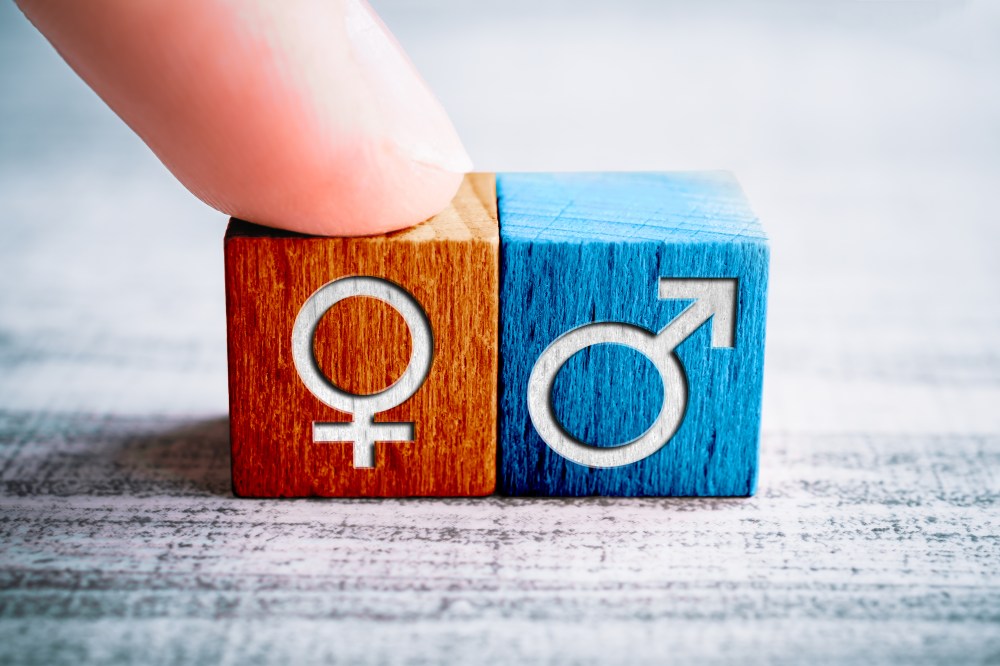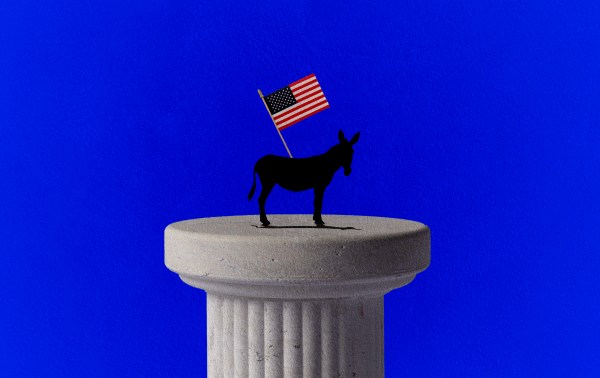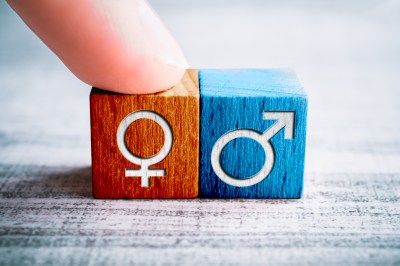“There are only two genders!” Up goes the battle cry from certain quarters of the right and from the president whose line they toe with such perfect servility. Over at Facebook, it was 54 genders before it was 72 before it was ... whatever it is today.
In reality, the number of genders is neither two nor 72 nor anything in between: The number of genders, outside of grammar textbooks, is zero. “Gender” is a grammatical term that became, over time, a figure of speech masquerading as an indelible (for purposes of discrimination law) yet infinitely fluid (for other rhetorical purposes) personal trait, one that is conflated—often intentionally, with its less malleable non-synonym, sex.
As George Orwell observed in his famous essay “Politics and the English Language,” the corruption of language goes hand-in-hand with the corruption of thought. One of the reasons we have such an excruciating time talking our way through sensitive questions about sex and about what we call “gender” is simple linguistic imprecision. The activists on the progressive side of this issue never cease shouting that sex and gender are not the same thing, and, in that much at least, they are correct–and we should start acting like it.
For example, there is a great debate about gender separation in sports and, in particular, how this affects women’s sports; but, historically speaking, we have not segregated sports by gender at all—we have segregated sports by sex. Gender had nothing to do with it, and the existence—in some contexts, the prevalence—of gender-nonconforming athletes in women’s sports has been such an obvious and observable phenomenon for so long that jokes about Bulgarian shot putters were a Cold War cliché well before many of the people reading this column were born. If the requirement to participate in women’s sports were sex, as it was from the beginning of women’s sports until the day before yesterday, then the exclusion of males of any and every gender sensibility follows obviously enough; but when the requirement is gender, you end up with the mess we have today. No one has elected me to speak on behalf of the proud and generations-long butch-lesbian athletic tradition, but my impression is that anybody who went back to 1978 and suggested that some of those golfers and pro bowlers and Olympians that might in fact be in some metaphysical way men might get punched in the face, hard. Which is not to suggest that the condition we describe with the adjective “transgender” is a fiction or that we should sneer at it—what we should try to do is to speak and write about it more intelligently and lucidly.
Sex is, for contemporary rhetorical purposes, excruciatingly boring. Rare abnormalities notwithstanding, sex is an observable, empirically verifiable characteristic, and, in human beings, there are two of them. The existence of intersex people and people with ambiguous genitalia, while a fruitful literary theme, is no more relevant to the fact of sexual dimorphism in H. sap. than the fact that people sometimes are born without a limb negates the bipedal nature of the species. A set of two sexes is by far the most common arrangement when it comes to species that reproduce sexually, though sometimes things get a little complicated with land snails (which mostly are hermaphrodites) and certain fungi that would need a few dozen pronouns, if fungi had pronouns indicating mating type. Such ambiguity is not an issue for our species. You can build whatever kind of philosophy you like on the foundation of that fact—from Christian “complementarianism” to the classical radical feminism of the 1970s—but the fact of sex is one of those “stubborn things” John Adams talked about.
Linguistically speaking, sex and gender have (in the Anglophone world) been getting in each other’s business for a few centuries. Gender, from the Latin genus and a twin sister of genre, has been used to refer to the sexes from time to time since Richard III was on the English throne. It had been a term from grammar, naming the categories in gender-inflected languages such as Latin. Grammatical gender in the languages that have it is only very loosely and vaguely associated with sex, but the analogy suggested itself, and the conflation of the words became common. It seems to me significant that the use of gender for sex, which had been relatively rare, became much more common and, eventually predominant, beginning around the same time that the meaning of sex began to shift from indicating male and female to indicating sexual intercourse. My pet theory is that the Anglophone world, culturally dominated by the prissy WASP sensibility of the British diaspora, began to rely on gender when saying sex began to make pale Anglo-Saxon complexions go a little bit red: “No Sex Please, We’re British!”
The more contemporary uses of gender are recent neologisms: Gender meaning the “behavioral, cultural, or psychological traits typically associated with one sex, as in ‘gender roles,’” as our friends at Merriam Webster put it, dates from the second half of the 20th century. “Gender identity” and “gender expression” were unknown expressions before the 1960s and 1970s, respectively.
Sex therapist Jackie Golob put it the way one most often hears it described: “Gender identity is how you feel about yourself and the ways you express your gender and biological sex. ... Biological sex is physical, while gender is feeling.” That is a common view, and it seems to me that it gets it about right. But if gender is a feeling, then there are as many genders as there are people—human beings are unique, individualistic, and idiosyncratic in how they understand themselves as members of sexes—and, hence, meaningless: Words that describe everything describe nothing.
One of the things we are talking about when we talk about gender expression is social convention—community expectations related to one’s membership in one sex or the other, expectations that vary radically from place to place, culture to culture, and time to time. To take an obvious example: skirts. In the United States and most of the Western world in Anno Domini 2025, skirts are considered attire appropriate to women. Of course, this is arbitrary—or, more precisely, it is a matter of custom and tradition rather than something that is or could be logically arrived at—and one need not think very hard to come up with examples of skirts and skirt-like garments that not only are considered perfectly masculine (the Scottish kilt, obviously) but that are ritually reserved to men, as in the case of a Catholic priest’s cassock. So, skirts and dresses are feminine garments ... except when explicitly restricted to men and to male-only occupations.
The fact that this is only convention and not some kind of existentially necessary fact of sexual difference does not mean that it is unimportant: When high-fashion designers such as Rick Owens and Yohji Yamamoto play with these sexual conventions in menswear, the aesthetic effect relies in part on the fact that their garments create some tension with our expectations of what men’s clothes are supposed to look like. (It is of interest that unlike the famous skirts-for-men enthusiast Thom Browne, neither Owens nor Yamamoto typically has chosen especially androgynous models for these garments and the overall effect is in many ways traditionally masculine, a kind of sci-fi hero look—or “arty ninjas,” as Simon Doonan called them.) Those conventions don’t have to be explained to anybody, any more than one needed footnotes to see that the punk-rock outfits of the 1970s or the androgynous glam-rock look of the 1980s were not pure sartorial abstractions but intentional experiments with (and mocking of) social conventions related, respectively, to class and sex.
St. Paul instructs the Corinthians: “Doth not even nature itself teach you, that, if a man have long hair, it is a shame unto him? But if a woman have long hair, it is a glory to her: for her hair is given her for a covering.” But, of course, we have all sorts of long-haired manly archetypes in the Christian world, from traditional depictions of Jesus to Charlemagne to the Cavaliers—and even many of the Puritans who detested the Cavaliers’ flowing locks had what we would consider, in our own place and time, hair that was long for men. What mattered wasn’t how long men’s hair was–it was how long men’s hair was relative to norms about the length of men’s hair and women’s hair. It isn’t a matter of absolutes but one of expectations. A gold wedding ring might denote a defining masculine role for a man (that of husband) in much of the world, while conservative interpretations of Islam regard any wearing of gold by men as haram, because such adornment (along with the wearing of silk) is considered essentially feminine. It is not that anybody is going to mistake Mr. T for a woman, however many gold chains were in his stack, or that Pete Davidson looks like a woman when he wears a dress—only that, in certain contexts, these modes of dress push people’s sex-role buttons. These things change: Only a few years ago, it was extraordinarily rare to see a heterosexual man wearing pearls unless, perhaps, he was a pirate; today, Joe Rogan’s protestations notwithstanding, pearl jewelry is routinely marketed to, and worn by, men, including professional athletes and other thoroughly non-androgynous types. Go tell Garrett Wilson he looks like a girl in that pearl necklace.
Americans traditionally are hysterical about this stuff as a matter of political rhetoric and social posturing while being extraordinarily tolerant—and curious, and even celebratory—as a matter of fact. There was a time in the assertively conservative Reagan years (right around 1983-84) when people made a very big deal about Boy George and how he looked, but the controversy (largely a recreational controversy) did not stop Culture Club’s “Karma Chameleon” from being the bestselling record in 20 countries while spending three weeks atop the Billboard chart in the supposedly puritanical United States. More recently, a figure such as Lil Nas X can do a duet with Billy Ray Cyrus on one day and perform in a gold bustier on another, arguably with less controversy than Boy George generated in his day.
I have, in the foregoing, intentionally avoided taking up people who identify as trans as my examples. But I will get to that issue here.
The American creed of “live and let live” is a two-way street, an expression of reciprocal obligation. And it is here, I think, that trans issues necessarily run into controversy. While I am not naïve enough to believe that violations of sexual norms in our society would be generally uncontroversial—or even necessarily safe—I suspect that most people of goodwill in these United States are capable of making a great deal of social room for people who wish to dress in a way that is at variance with sexual convention, to use a name associated with the opposite sex, and generally to live his or her life in the way that seems best to him or her. The tensions begin when others are expected to participate in this. Some accommodations are relatively easy, straightforward issues of courtesy and good manners—for example, addressing people as they prefer to be addressed. Other accommodations are not as easy, and some of those accommodations, such as the participation of men in women’s sports, probably should not be made at all, at least as a general matter. And this gets us back to the question of gender vs. sex: It is one thing to expect courtesy and social accommodation, and another thing to ask—to demand, including at times as a condition of employment or other kinds of social participation—that people pretend to believe something that they do not believe and that is not true: that people who are members of one sex are members of the other sex. “Live and let live” is either a duty of both parties or a duty of neither party—the proposition is conditional.
Conservatives complain, and not without reason, that the left is the traditional aggressor in the culture wars. And it is, of course, possible to be a person of goodwill and to act in a spirit of generous liberality without also signing up for radical and in some cases nonsensical theories about sex and gender, without taking upon oneself an obligation to participate, however politely, in a fiction. But is that how conservatives have been conducting themselves of late? It would be very difficult to argue that this is true. The Trump administration has recently decided to revisit these questions as they relate to military service, publishing an executive order that reads, in part:
Consistent with the military mission and longstanding DoD policy, expressing a false “gender identity” divergent from an individual’s sex cannot satisfy the rigorous standards necessary for military service. Beyond the hormonal and surgical medical interventions involved, adoption of a gender identity inconsistent with an individual’s sex conflicts with a soldier’s commitment to an honorable, truthful, and disciplined lifestyle, even in one’s personal life. A man’s assertion that he is a woman, and his requirement that others honor this falsehood, is not consistent with the humility and selflessness required of a service member.
Set aside the poor grammar and the hilarious hypocrisy (Donald Trump cares a lot about an “honorable, truthful, and disciplined lifestyle, even in one’s personal life”?) and the necessarily relevant issue of Trump’s own remarkable personal cowardice vis-à-vis military service, which did, in the matter of the imaginary bone spurs that kept his out of the Vietnam draft, involve a “requirement that others honor this falsehood”—the administration naturally is proceeding with maximum stupidity, cruelty, and incompetence, among other things by documenting in its own words sufficient evidence of its sheer imbecilic malice to put the order on shaky legal ground from the beginning.
There is a much more direct way to deal with this question, which is to maintain that a soldier’s gender sensibility is of no particular interest to military managers where it does not interfere with the performance of ordinary military duties, but that we do not organize military units according to gender identity—we organize them, in part, according to sex. The role of the military is not to serve as a vehicle for social justice projects, however well-intentioned—the role of the military is to kill people and destroy property, and, presumably, there are some men and women who are good at that kind of thing who do not have a traditional sense of themselves when it comes to the sex-role conventions. It is not very difficult to imagine situations—which would depend largely on the character of the people involved—in which this would present no problem at all, while other kinds of situations, particularly those involving men and women more interested in social activism than in soldiering, in which the obstacles would be insurmountable, or not worth surmounting. Unfortunately, a sensible modus vivendi would require a Trump administration that is less aggressively stupid and a trans-activist community that is more “live and let live” than “do as you’re told.”
The existence of people who strongly identify with the opposite sex is a longstanding phenomenon, familiar across many different historical periods and cultures. Men who wish to present themselves as women and to be perceived and treated as women are more familiar to us than the opposite case, but this may simply be another example of the fact that the historians have for a long time written a lot more about men than women. For example: We do not know enough to necessarily credit the legends surrounding Elagabalus, the teenaged third-century Roman emperor reported to have presented himself as a woman and who supposedly sought to undergo a kind of primitive sex-reassignment surgery, but we can surmise that his enemies (and his biography was written by an enemy, Cassius Dio) did not concoct their libels (if they are libels) out of pure imagination, that such stories and experiences were familiar enough to those late-empire Romans to be used as part of the arsenal of political narrative. This kind of thing has been around for a long time, and there are many different versions of it. The transgender phenomenon as we understand it and talk about it today is about five minutes old, historically speaking, and it probably will be a very different thing in 20 years, just as gay life in 2025 is very different from what it was in 1975 and is very different in Paris than it is in Karachi, just as the patterns of behavior that could be described as “homosexual” were so different in, say, Rome 2,200 years ago and in Atlanta today as to hardly qualify as being examples of the same thing.
In that sense, the people who talk about a “spectrum” of gender expression have it more right than wrong—so right, it seems to me, as to leave many of our efforts at categorization more or less useless. But, as with sexual orientation—which is a crude and simplistic way of trying to categorize the bewildering variety of observed real-world human sexual behavior—our categorical approach to what I guess we’re stuck calling “gender” is shaped by a few distinctly American—and frequently destructive—habits. One of these is the effort to medicalize or science-ize everything under the sun, especially social differences. This is really only a variation on the old “appeal to authority” rhetorical stratagem. And that is related, in part, to a second bad American habit: trying to make every question involving marginalized groups into the civil rights movement. For years, activist researchers worked diligently in search of a genetic explanation for homosexuality—the mythical “gay gene”—not because this offered a useful account of real-world sexual behavior (there are 10,000 different patterns of sexual life that could all be lumped together under the heading “homosexual”) but because it would have been useful to certain activists to be able to present the condition of being gay as morally and biologically equivalent to the condition of being black, so that those who had reservations about this or that change to sexual mores and norms could be denounced as the equivalents of Bull Connor or Senator Byrd or Orval Faubus. But sexuality and race are not equivalent things, the respective social situations of gay Americans and black Americans are not and never have been equivalent, and opposition to same-sex marriage is not and never has been the equivalent of opposition to interracial marriage. Trying to make social questions into scientific questions—as though the effort, even if successful, would somehow eliminate the underlying social question—is mainly a rhetorical exercise rather than a scientific one. As is trying to make every agonized out group of the 2020s into the viciously oppressed African Americans of the 1940s.
I wish it were not necessary to state explicitly here my conviction that we should proceed in this with kindness, courtesy, decency, and no ill will—but also with clear eyes and intellectual integrity. People who identify as trans have relatively high rates of suicide as well as other troubles such as drug abuse. Some of this is a result of the fact that the world can be cruel and lonely for many of them; some of it isn’t at all the result of that fact. I myself have a relatively broad tolerance for variety and experimentation in the private sphere but take a relatively narrow view of what finally leads to a genuinely good life. Being a conservative, I also have a tragic view: that the kind of happiness we all want for ourselves and others is not fully possible for any of us in this fallen world and may be far out of reach for others, not necessarily through any fault of their own or any decision of their own making. There are wounds that do not heal and obstacles that cannot be overcome. Of course this is to be experienced in particularly profound ways in our lives as men and women, husbands and wives, and fathers and mothers—it is these elemental things that makes the fact of sex so much more powerful than the shifting rhetoric—and fashion—of gender.
Working through this should be possible for intelligent people of goodwill—but, as Adlai Steveson lamented when a supporter told him he had the support of every thinking person in America: “I’m afraid that won’t do—I need a majority.”
Words About Words
Having run quite long in the above, I will keep the rest brief. From the New York Times, which at times has almost enough trouble with capitalization to be running Donald Trump’s social media:
Especially because Anna Wintour, the Met Gala’s mastermind, a powerful democratic fund-raiser and the chief content officer of Condé Nast, said on “The Late Late Show” in 2017 that the one person she would never invite back to the fete was Mr. Trump.
Anna Wintour is a fund-raiser for the capital-D Democratic Party. (De gustibus, etc.) I have never met her, but I think I would like her (which is not to say I think she would like me) because she is, by many accounts, the least democratic woman in the United States of America, one who never has been shy about her enjoyment of her power, position, and wealth. Don’t we need a few of those around?
Democracy? Sure, on Election Day. But not at Vogue. Let’s not let it get out of hand.
Elsewhere
You can buy my most recent book, Big White Ghetto, here.
You can buy my other books here.
You can check out “How the World Works,” a series of interviews on work I’m doing for the Competitive Enterprise Institute, here.
In Closing
Upon learning that an American cardinal has been elected pope, President Trump wrote: “[W]hat a Great Honor for our Country.” Capitalization issues being the least among the relevant concerns, you can see much of what is wrong with Donald Trump in those few words. The elevation of Robert Prevost to the papacy is not a great honor for our country—or for him. The papacy is a position of service—to the poor, to the despised, even to illegal immigrants and criminals. Donald Trump loves the idea of a “Great Honor,” wouldn’t know service if it sued him in bankruptcy court, and hates the sort of people the pope serves—and Jesus served. Trump is from the camp of Herod and Pilate, the sort of man who would have complained that the Romans should have tortured Jesus more—and should have gone after Mary, too: “When they say they don’t care about their lives, you have to take out their families.”
It is not the pope’s honor—or America’s honor, or the honor that Donald Trump would have if he were a better sort of man—that is relevant here. It is a different kind of honor entirely.







Please note that we at The Dispatch hold ourselves, our work, and our commenters to a higher standard than other places on the internet. We welcome comments that foster genuine debate or discussion—including comments critical of us or our work—but responses that include ad hominem attacks on fellow Dispatch members or are intended to stoke fear and anger may be moderated.
With your membership, you only have the ability to comment on The Morning Dispatch articles. Consider upgrading to join the conversation everywhere.